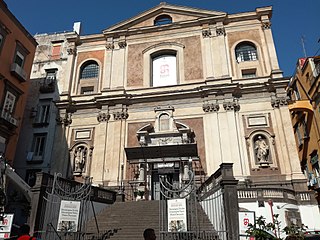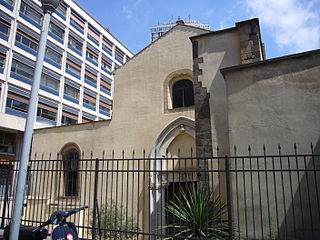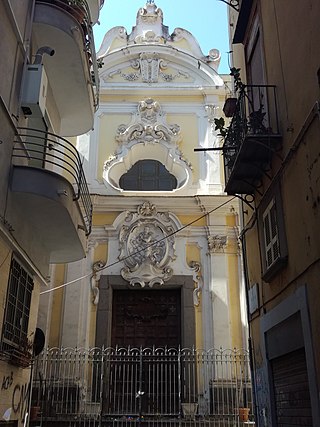
Luca Giordano was an Italian late-Baroque painter and printmaker in etching. Fluent and decorative, he worked successfully in Naples and Rome, Florence, and Venice, before spending a decade in Spain.

Belisario Corenzio was a Greek-Italian painter, active in Venice and Naples. He is one of few Greek painters that did not belong to the Cretan Renaissance like his contemporaries of the time. He escaped the maniera greca completely. He adopted the Venetian style. Other similar Greek painters were Marco Basaiti, Ioannis Permeniates, Antonio Vassilacchi and El Greco. He was sometimes referred to as Il Greco. His teacher was prominent Venetian painter Tintoretto. In 1590, at age 32 Corenzio settled in Naples. Corenzio was influenced by Cavalier d'Arpino. He continued to flourish in the region. His apprentices included: Luigi Rodriguez, Andrea di Leone, Onofrio De Lione and Massimo Stanzione. Corenzio painted many frescos that survived today. Some of his works are in the Church of San Severino and Certosa di San Martino. His style resembles Caravaggio. An Italian legend in Naples exists involving Corenzio, Spanish painter Jusepe de Ribera, and Battistello Caracciolo. They were referred to as the Cabal of Naples. The three painters were rumored to have poisoned their competition for painting contracts. The rumors lack documented evidence. The three painters were very popular in Naples. Corenzio frescoed the Crypt that holds the remains of Matthew the Apostle at Salerno Cathedral and it depicts scenes from the Gospel of Matthew. Corenzio was one of the most celebrated fresco painters in Naples during his time. His drawings can be found all over the world namely at the Metropolitan Museum, Museo di Capodimonte and Louvre.

Santa Maria Donnregina Nuova is a church in central Naples, Italy. It is called Nuova ("new") to distinguish it from the older Angevin church of Santa Maria Donna Regina Vecchia.

Castel Nuovo, often called Maschio Angioino, is a medieval castle located in front of Piazza Municipio and the city hall in central Naples, Campania, Italy. Its scenic location and imposing size makes the castle, first erected in 1279, one of the main architectural landmarks of the city. It was a royal seat for kings of Naples, Aragon and Spain until 1815.
This is a list of music conservatories in Naples, Italy.

Santa Maria la Nova is a Renaissance style, now-deconsecrated, Roman Catholic church and monastery in central Naples. The church is located at the beginning of a side street directly across from the east side of the main post office, a few blocks south of the Church and Monastery of Santa Chiara. Today the adjacent monastery is a meeting site and hosts the Museo ARCA of modern religious art.

Sant'Anna dei Lombardi,, and also known as Santa Maria di Monte Oliveto, is an ancient church and convent located in piazza Monteoliveto in central Naples, Italy. Across Monteoliveto street from the Fountain in the square is the Renaissance palace of Orsini di Gravina.

Santa Caterina a Formiello is a church in Naples, in southern Italy, located at the extreme eastern end of the old historic center of the city, on Via Carbonara and Piazza Enrico de Nicola, near the gate called Porta Capuana. The term Formiello comes from the forms or containers for water spouts found in the convent. Diagonally across the street and South is the Fontana del Formiello against the rear wall of the imposing Castel Capuano.

The Ospedale degli Incurabili or Complesso degli Incurabili is an ancient and prominent hospital complex located on Via Maria Longo in central Naples, Italy. Part of the complex, including the remarkable pharmacy, are now the Museo delle arti sanitarie of Naples.

The Basilica of Santa Maria della Sanità is a basilica church located over the Catacombs of San Gaudioso, on a Piazza near where Via Sanità meets Via Teresa degli Scalzi, in the Rione of the Sanità, in Naples, Italy. The church is also called San Vincenzo or San Vincenzo della Sanità, due to the cult of an icon of San Vincenzo Ferrer, also called locally O' Monacone.

Santa Maria della Verità is a church in rione Materdei, in the quartiere of Stella of Naples, Italy. The entry is located on Via San Agostino degli Scalzi, number 6.

Santa Maria Donnaromita is a former church located on via Paladino in Naples.

Santa Maria dell'Incoronata is an ancient church on Via Medina in Naples, Italy. It is located just south of San Giorgio dei Genovesi and across the street from the Church of Pietà dei Turchini.
Santa Maria Assunta dei Pignatelli is a deconsecrated Roman Catholic church located at the end of Via Nilo in Naples, region of Campania, Italy. In the small piazza in front of the church is an ancient Roman statue of the Nile God.

Santa Maria Regina Coeli is a Roman Catholic church in central Naples, Italy.

Santa Maria della Sapienza is a Roman Catholic church, located on Via Costantinopoli in central Naples, Italy.

The church of Santi Severino e Sossio and the annexed monastery are located on via Bartolommeo Capasso in Naples, Italy.
The Palazzo Ricca is a monumental palace, located on the southernmost end of Via dei Tribunali #231, in central Naples, region of Campania, Italy. It presently houses the archives of the Foundation of the Istituto Banco di Napoli. The palace is just down the street from the entrance to Castel Capuano

Santa Maria Avvocata is a Catholic church located at the end of Via Avvocata in Piazza Dante in the Historic Center of Naples, Italy.

Pietro de Marino was an Italian architect born in Naples and active there between 1629 and 1666. His works include the former church of San Potito.





















